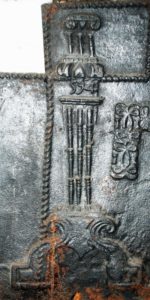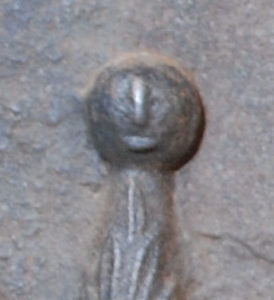
What seems to be a feature unique to English firebacks is the use of andirons, or firedogs, as decorative stamps. I have come across eight different examples, on the complete ones of which they are arranged as pairs or trios. This may be for the purposes of symmetry but the trios may also have an apotropaic, or evil-averting, function, trios being suggestive of the Holy Trinity. Andirons, of course, date back to much earlier than firebacks, blacksmiths fabricating them out of wrought iron, which they continued to do after cast iron ones were introduced in the sixteenth century. Only the cast dogs were used to decorate backs, often, no doubt, because they incorporated decorative elements in their own right, such as initials, shields or dates, and enabled their owners to complete sets of personalised hearth furniture.

One or two have been quite elaborate in their design, such as the examples seen here on firebacks in houses near Rogate and Wisborough Green. The latter may have included some elements of brass as well as iron.
It is very satisfying, therefore, to encounter andirons of the type that have been noted on firebacks and, so far, two have come to light. The first can be seen on two slightly different backs, one in the Victoria and Albert Museum (see below) and the other in the Sussex Archaeological Society’s collection at Anne of Cleves House, in Lewes. They are varied only by the number and placement of fleurs-de-lys. The dogs displayed have distinctive twisted stems and a shield that bears the crossed staple badge of the Nevill family who, as Lords Bergavenny or as a cadet branch from Berkshire, operated ironworks in the Sussex Weald in the 16th century.


While I have yet to find an exact example of the firedog, a pair survives that differ only in that on the shield they bear the initials ‘RH’ instead of the staples (see right). It would be tempting to ascribe those initials to Ralph Hogge, the pioneering Wealden gun founder, but there will have been plenty of other people to whom those initials could have applied.

A fireback in Hastings Museum, that has been illustrated in several articles in the past, has a trio of andirons on which is a small shield with the initials ‘RW’ (see below). The back came to the museum from Cralle Place, at Warbleton in east Sussex, which had been the home in the 1500s of Richard Woodman. He was a yeoman farmer and ironmaster, but most famously was a martyr to his Protestant faith during the reign of Queen Mary I, being burnt to death with nine others in Lewes in 1557. It is not too far-fetched to suppose that the initials on the andirons could have been his.



Excavations in 2017 at Bridge Cottage, an old house in Uckfield, Sussex, turned up a single casting of an andiron of almost identical design down to the same initials, though with one minor difference. The rounded knob on the top of the dog shown on the fireback has a primitive face, while the excavated one does not.